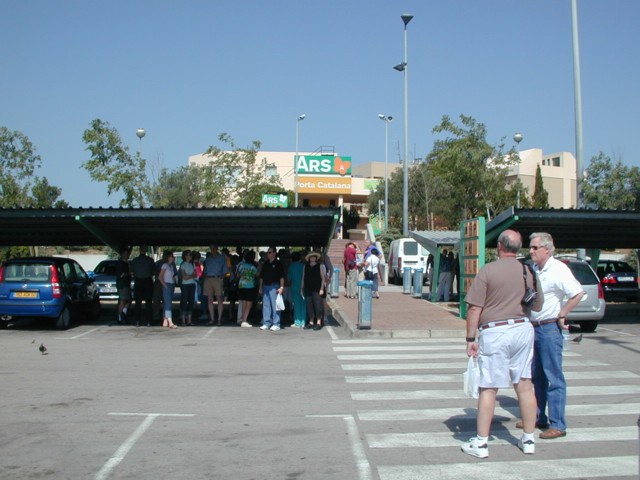
I should have mentioned yesterday that, after our pilgrimage to Montserrat, we returned to Barcelona with plenty of time for independent exploration, and many choir members fanned out across this exciting city and had a variety of adventures. I, however, went back to the hotel and crashed for a few hours, then stayed in to write the day's webpage, so I don't have much to report. Ask the others when they get back!

This morning we got up (early!) and loaded the buses, then headed north across the border into France. We didn't cross the Pyrenees, though we saw their snow-capped tops in the distance; rather, we went along the Mediterranean coast and north through the foothills before turning west toward Carcassonne. As you can see from the way most people sought shade at this rest stop before crossing the border, it was plenty hot in Spain; however, when we got out at Carcassonne, it was sunny but significantly cooler. There was also a very stiff breeze blowing intermittently; being between two mountains, the town gets the same "wind tunnel" effect as the San Gorgonio pass closer to home, and like that pass, it had numerous electricity-generating windmills that we saw from the road. Way too tall for Don Quixote, though! (I didn't get a chance while in Barcelona to follow up on the interesting connections that city has to Cervantes and his famous creation; you may have noted, though, on Monday's webpage, that there was a scholarly meeting on the subject going on at the palace.)
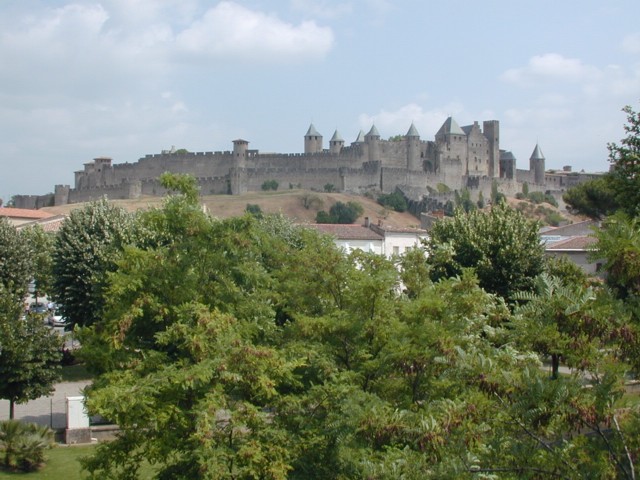
The medieval city of Carcassonne, built on top of a Roman town dating to the second century B.C., is a UNESCO World Heritage Site, like the Palau de la Musicá Catalana; it possesses some of the most extensive and best preserved fortified city walls in Europe. It is at the center of one of the bloodiest events in Europe before the 20th century, the Albigensian Crusade. The Albigensians, or Cathars, or any of a variety of other names mostly given to them by their enemies, the Catholic Church, rebelled against clerical corruption and worldliness between the 11th and 13th centuries, hundreds of years before the Protestant Reformation. Their doctrine was much like Manicheanism, positing that the loving God preached by the Catholic Church would never have allowed the plagues, wars, famines, and other terrible events of the time to have happened to men; rather, the physical world was created by the Prince of Darkness, and Jesus, rather than having been sent by (and being One with) the Creator, was instead an emissary sent by the Light to lead men out of his clutches. Among other things, they held that a person had to work his own way to salvation, not hope for it as a gift from above, and they blamed the Catholic hierarchy for putting obstacles in man's path. This was of course heretical throughout the Christian world led from Rome, but in the southwest of France, the region known as Langedoc (a name that I think comes from its people's language, Langue d'Oc, also known as Occitan), it became quite strong and was tolerated, along with Judaism and Islam in many cases, by the local lords. From 1209 to 1229, Pope Innocent III and his successors sponsored a Crusade to annihilate this heresy; in the first major battle, the Crusaders massacred all twenty thousand citizens of Béziers, Catholic or heretic. You may have heard the phrase "kill 'em all--let God sort 'em out"; this is an echo of an order attributed to the leader of the Crusaders to "kill them all--God will recognize His own!" In war and in the French Inquisition that continued for almost a century afterward (and again, centuries before the better-known Spanish Inquisition), almost a million people died.
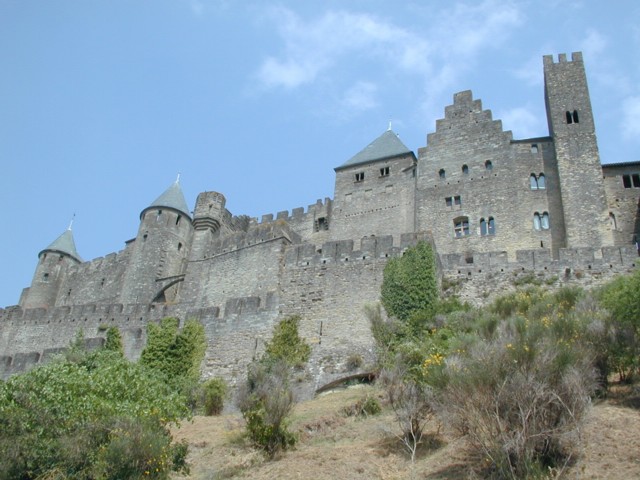
Rather a long historical and theological lesson, but walking around this fortress you get the idea that there are some good reasons that it was built strong and then strengthened further over the centuries. The town founded by the Romans was originally unfortified, but a few centuries later the first walls were built as the barbarian invasions came ever closer. The medieval period saw the raising of the inner wall atop the Roman wall, with the Château Comtal (Count's Castle), seen here, extending to the wall. After the Crusade, the French kings built the outer wall, as the border between Spain and France was very close to Carcassonne at the time and fortresses were needed to protect the frontier.
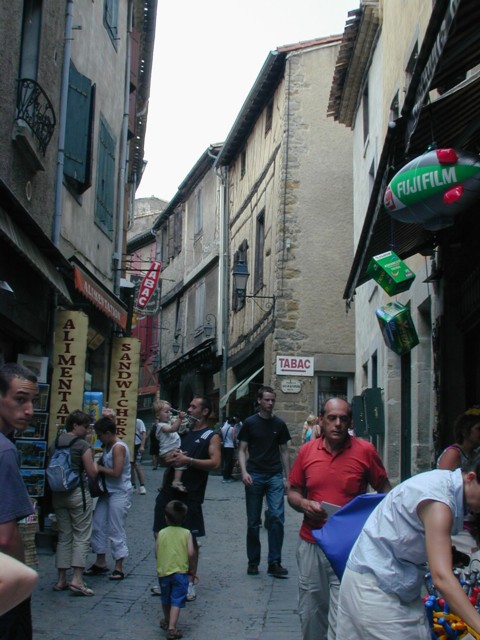
We had time to explore the city independently before and after a guided tour of the Château. Inside the walls, as you might expect, things were pretty tightly packed, though there were some broader avenues near the castle. Not surprisingly, since Carcassonne welcomes something like two million visitors each year, most of the shops catered to tourists, selling souvenirs, snacks, film, and postcards.
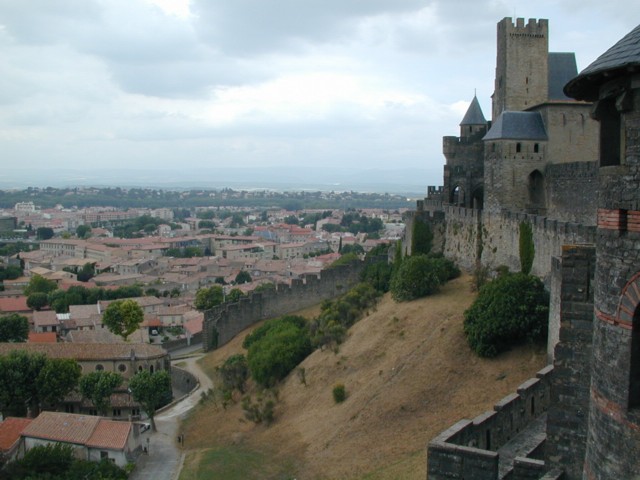
After the Albigensian Crusade, as the old city became more of a garrison fortress, a new town called Bastide Saint-Louis grew up nearby, mostly across the river L'Aude. On the subject of names, the old city is known as La Cité; as I understand it, this term is generally applied in France to those portions of any city that date to Roman times. The name Carcassonne has a legend behind it, having to do with the seige of the city by the Franks to drive out the Saracens who occupied it for a few years in the eighth century. When the food inside the walls was running out, a Saracen princess named Carcas suggested that they take their last pig, cook it, and catapult it over the walls to the beseigers. This would be a boast to their enemies that they had so much food that they could afford to waste it, and thus that the seige was not going to succeed. When the ruse worked and their enemies lifted the seige, Carcas had the bells in town rung, and the "sound" of the bells ("sonne") plus her name became the name of the city. Anyway, that's the legend; actually, the name goes back to the Romans, who called their town Carcasso, from a word meaning "stone," in reference to the stone hill on which it was set. Oh well.
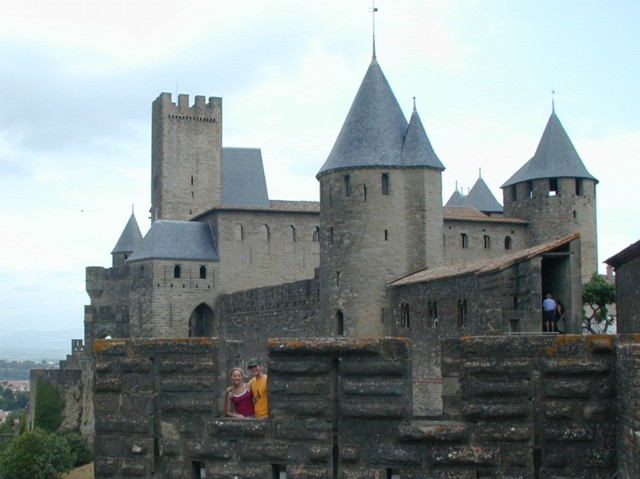
With the advent of gunpowder, fortresses like this became less impregnable; then in 1659 a treaty moved the Spanish/French border well to the south, so that Carcassonne was no longer militarily useful. The town became a backwater; however, that circumstance resulted in the survival of the walls, since in more successful cities the walls were eventually pulled down to accommodate growth (in Barcelona, for example). But here the medieval fortifications survived into the 19th century, when a project of renovation began that resulted in their being here for us to enjoy today. (The gray slate roofs, by the way, are an error of those restorers, as the towers would actually have had flat stone roofs on which soldiers could mass.)
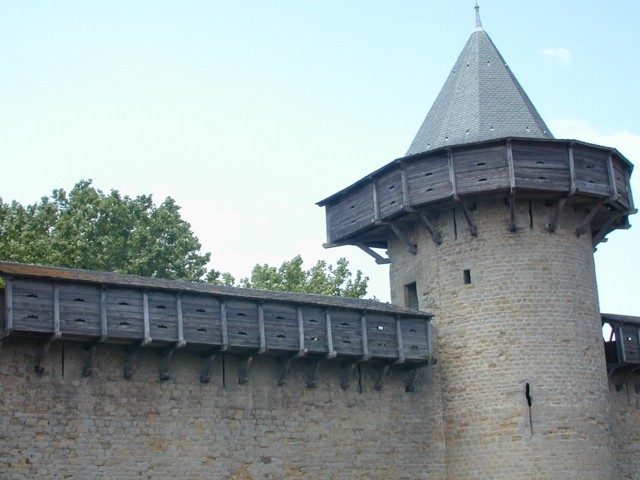
You may have noticed numerous vertical slits and horizontal rows of holes in the preceding pictures of the walls of the city and Château; these were for the protection of archers. The holes allow mounting of temporary wooden shields like these, which protect archers leaning out to shoot at enemies at the foot of the wall.
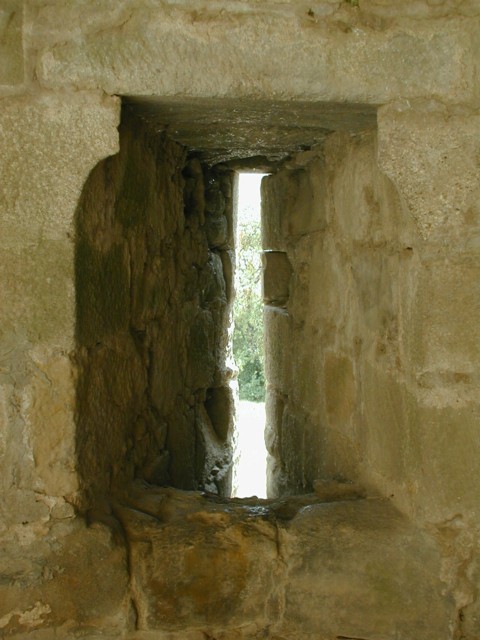
The slits open up inside at an angle, so that an archer could move from side to side to command a substantial field of fire while still presenting only the narrowest of openings for enemy marksmen.
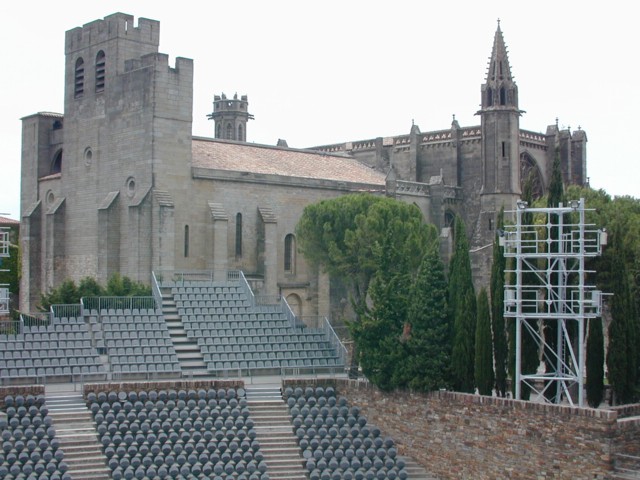
The Basilique Saint-Nazaire inside the city walls is a hybrid between the Romanesque (near) and Gothic (far) styles. After the Crusade, the new rulers, mostly from northern France, asked for the Romanesque church to be replaced with a form more familiar to them from their home regions; for some reason, the request was only partially granted, with demolition and reconstruction of one end of the church. The windows are original, dating from that time; unfortunately, I didn't have time to go inside and take a look. In the foreground are the upper rows of seats and a light tower from a large modern theater just inside the walls; the Kuchs, who came here in 2002, suggested that we try to get "booked" to sing here on this tour, but that didn't happen. Even without that, we have plenty of vivid memories to carry home from Carcassonne!
 To
Thursday, 30 June 2005
To
Thursday, 30 June 2005 Back
to choir tour itinerary
Back
to choir tour itinerary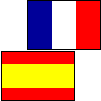 Back
to choir tour home page
Back
to choir tour home pagenew 29 June 2005